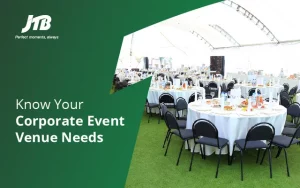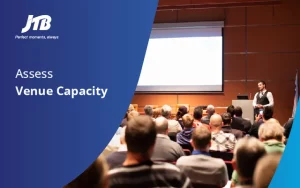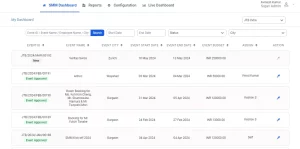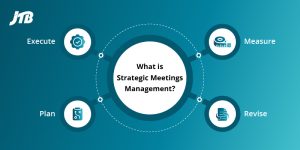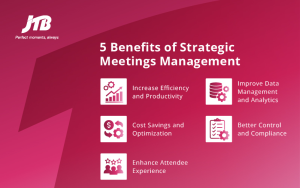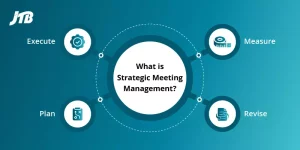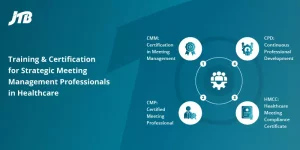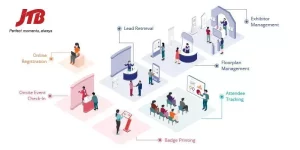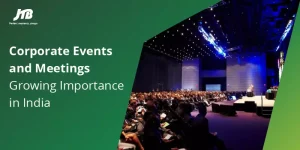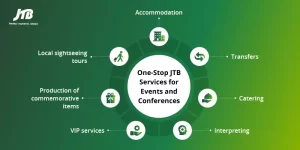8 Expert Tips for Choosing the Best Corporate Event Venues
Do you struggle to pick the perfect corporate event venue for your upcoming corporate events and meetings?
You’re not alone. Many face this challenge regularly, often resulting in either outsourcing event planning services or settling for unsuitable venues.
This is where the importance of selecting the ideal corporate event venue comes in. It can either enhance the experience or disappoint attendees.
Many attendees think the venue can make your event great or lead to a disappointing experience. This also highlights the importance of choosing the right space tailored to your business needs.
Imagine a corporate event venue that fits your needs. It offers super easy access and meets all your requirements.
It’s more than just a location; it’s a precisely curated space reflecting your corporate identity and ensuring a positive impact.
This is where we come into play. JTB India has a vast network that covers 35 countries, allowing us to pinpoint the perfect location for your business event. Interested in our strategy? We’ve put together eight tips to clarify our process.
These tips will help you choose the ideal event party venue that not only meets your event objectives but also creates an unforgettable experience for your attendees.
Let’s get started.
Tip 1: Know Your Corporate Event Venue Needs
Understanding the needs of your corporate event venue is essential for planning a successful event. To determine these needs, it’s crucial to clarify the concept, objectives, and desired outcomes of your event.
Concept: Begin by defining the overarching concept or event theme based on your choice. Whether it’s a product launch, team-building retreat, or conference, understanding the concept will guide your venue selection process.
For example, if the concept revolves around sustainability in corporate activities, you’ll need to prioritize venues that offer eco-friendly amenities and practices.
Objective: Next, identify the specific objectives you aim to achieve through the event. Are you looking to foster team collaboration, showcase a new product, or celebrate company milestones? Each objective may require different venue features and facilities.
For instance, if the objective is to enhance team cohesion through outdoor activities, you’ll need a venue with ample outdoor space and recreational amenities.
Needs: Once you have a clear concept and defined objectives, outline the specific needs and requirements for your event. Consider factors such as the number of attendees, types of activities planned, technical equipment needed, catering options, and accessibility. Create a detailed list of these needs to serve as a guide during the venue selection process.
For example, if you’re planning a corporate party focused on team-building activities for 50 attendees, you’ll need a venue with spacious outdoor areas and accommodation options nearby. Additionally, if sustainability is a key objective, prioritize venues that offer sustainable experiences and eco-friendly practices.
By understanding your event concept, objectives, and needs, you can select a venue that aligns perfectly with your goals and ensures a memorable experience for attendees.
Tip 2: Consider the Accessibility of Your Corporate Event Venue
Accessibility refers to how easily attendees can reach your event venue, encompassing factors like proximity to public transportation, availability of parking, and venue visibility. Ensuring accessibility is vital to maximising event attendance and success. If attendees encounter difficulties reaching the venue, it may deter participation, impacting your event’s outcomes.
When assessing accessibility, consider your attendees’ transportation needs. If many are travelling from afar, prioritise venues near transportation hubs. In India, unique considerations for accessibility may include the availability of public transportation options such as metro stations, etc.
For those driving, ample parking nearby is essential. Tailoring venue selection to attendees’ travel preferences enhances convenience and boosts event participation rates.
Tip 3: Assess Venue Capacity
Assessing venue capacity involves determining if a venue can comfortably accommodate all your event attendees. It’s important to choose a venue with a party hall that isn’t too crowded or too big for your corporate party. Also, 64.6% of attendees agree that the venue can make or break their event experience.
Ensuring the right venue capacity guarantees a smooth event flow and ample space for attendees to move around comfortably. A venue that’s too small may create a cramped and uncomfortable atmosphere, while one that’s too large can make your event feel empty and lack excitement.
To assess venue capacity, estimate the number of attendees you expect. Then, search for venues that can comfortably host that number, considering factors like seating arrangements, presentation space, and additional areas for activities or networking.
Tip 4: Evaluate Amenities and Facilities
When evaluating amenities and facilities, consider the additional perks and services a venue offers beyond its basic space. These extras can include audiovisual equipment, catering services, and Wi-Fi availability. Such amenities are crucial in enhancing the overall attendee experience, making your event more convenient, comfortable, and memorable for all participants.
Choosing a venue with the right amenities ensures that your event runs smoothly and meets the needs of your attendees. To begin, create a list of essential amenities and facilities required for your event, such as sound systems, projectors, or catering options.
When assessing potential venues, inquire about these amenities and assess whether they align with your event needs. Consider factors like quality, availability, and any additional costs associated with these services. Un
Tip 5: Review Venue Reputation and Reviews
According to a survey by BrightLocal, 87% of consumers read online reviews for local businesses, including event venues, before making decisions. Additionally, research from Trustpilot found that 89% of consumers consider online reviews as influential as personal recommendations when making purchasing decisions. These statistics underscore the significance of thoroughly reviewing venue reputation and customer feedback in event planning.
When reviewing venue reputation and customer feedback, it’s crucial to research potential event venues and read reviews from past clients or attendees.
This process helps you assess the venue’s quality and the satisfaction level of previous users, ensuring a successful event. Positive reviews indicate excellent service and meeting clients’ needs, while negative feedback or a poor reputation may signal potential issues.
To begin, search for the venue online and explore its website, social media pages, and review platforms like Yelp or Google Reviews.
Pay attention to overall ratings, comments, and testimonials from previous clients, focusing on recurring themes or specific feedback related to your event needs. Additionally, consider reaching out to past clients directly for more insights into their experiences.
Tip 6: Budget Considerations
Budget considerations are crucial when selecting a corporate event venue. This involves assessing costs associated with venue rental, amenities, and additional services to ensure alignment with budget constraints. Setting a realistic budget prevents overspending and maintains financial viability.
By considering venue price range and negotiating pricing, you maximise budget value and resource allocation.
Determine the overall event budget and allocate a portion for the venue—research venues, comparing pricing structures, locations, capacities, and amenities. Contact venues directly for pricing options, discounts, or package deals, and be mindful of hidden costs such as service fees and taxes.
Tip 7: Visit Potential Venues
Visiting potential venues allows you to evaluate the venue’s suitability firsthand and assess whether it meets your specific requirements and preferences. While online research and virtual tours provide valuable insights, nothing compares to experiencing a venue in person. Also, visiting good corporate event venues enables you to gauge factors such as ambiance, cleanliness, layout, and overall atmosphere.
To begin, compile a list of potential venues based on your event requirements and preferences. Contact each venue to schedule a site visit or venue tour.
During the visit, pay attention to details. Look at the condition of the facilities, cleanliness, and the overall atmosphere. Also, check their terms and conditions.
Consider bringing your event venue checklist of key factors to evaluate, including the venue’s capacity, layout, accessibility, parking facilities, and available amenities. Take photographs and notes to help you compare and make an informed decision.
Tip 8: Incorporate Corporate Event Specialists and Technology for Seamless Event Management
Arranging a corporate event involves a multitude of tasks, from identifying requirements to securing reservations, all within a short timeframe. It can be overwhelming to manage everything manually. That’s where corporate event specialists like JTB India and technology come into play.
Corporate event specialists bring expertise and industry knowledge to the table. They understand the nuances of event planning, from selecting the perfect corporate event venue to negotiating budgets. By leveraging their experience, you can streamline the planning process and ensure a successful event.
In addition to human expertise, technology like JTB Connect plays a crucial role in modern event management. This event management software and tools are designed to simplify tasks and automate processes. It helps you create timelines, manage the number of guests, track expenses and more, all from a centralised platform. By utilising event management technology, you can save time, reduce errors, and improve efficiency throughout the planning process.
By incorporating both corporate event specialists and technology into your event-planning strategy, you can navigate the complexities of organising a corporate event with ease. Whether you’re hosting a small meeting or a large conference, these resources will help you execute a memorable and successful event.
That was all from our tips, let’s conclude now.
Conclusion
Selecting the right corporate event venue is paramount for the success of corporate events. By aligning venue features with event objectives, considering accessibility, assessing capacity, evaluating amenities, reviewing reputation, managing budget effectively, and visiting potential venues, event planners can ensure a seamless and memorable experience for attendees.
Implementing these tips empowers event planners to make informed decisions and choose venues that meet their requirements.
From enhancing attendee experience to optimising budget utilisation, selecting the right venue lays the foundation for a successful event. JTB India offers unparalleled services in strategic meetings management, corporate events, and MICE.
With our expertise and dedication, we tailor our services to meet your specific needs, ensuring flawless execution and memorable experiences for your attendees.


